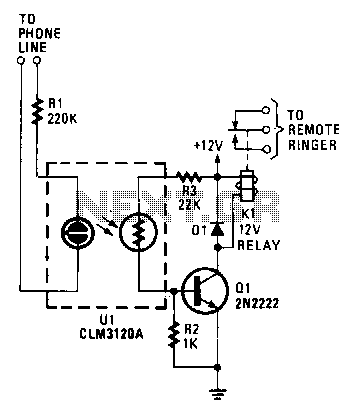
Ringer-relay

When the phone rings, the ring signal from the telephone company activates a neon lamp within a CLM3120 optocoupler. This activation results in a decrease in the resistance of the CdS cell output of the device, which in turn switches on transistor Q1. As Q1 turns on, relay K1 is energized. The circuit should be connected in series with the lamp that is to be activated.
The described circuit utilizes a CLM3120 optocoupler to isolate the telephone line from the control circuit, ensuring that high voltages present in the telephone line do not affect the low-voltage components of the activation circuit. The neon lamp serves as an indicator and a triggering mechanism that responds to the ringing signal from the telephone line.
When the telephone rings, the alternating current (AC) signal causes the neon lamp to illuminate. The neon lamp’s illumination indicates that the optocoupler is triggered, which causes a significant drop in the resistance of the CdS (cadmium sulfide) cell. This change in resistance is critical as it allows for a sufficient current to flow through the base of transistor Q1, turning it on.
Once Q1 is activated, it allows current to flow through the relay coil of K1. The relay acts as a switch, enabling it to control higher power circuits, such as lamps or other appliances, that are connected in series with the relay's contacts. This configuration ensures that when the phone rings, the relay closes, completing the circuit and energizing the connected lamp.
It is essential to select the appropriate relay based on the load requirements of the lamp, including its voltage and current ratings. Additionally, the circuit should incorporate necessary protective components, such as diodes across the relay coil, to prevent back EMF from damaging the transistor when the relay is de-energized. Proper design considerations must also include the ratings of the neon lamp and the CdS cell to ensure reliable operation under varying conditions. The overall design provides a simple yet effective solution for activating a lamp in response to an incoming phone call.When the phone rings, the ring signal from the telephone company lights a neon lamp within a CLM3120 optocoupler. That causes a drop in the resistance of the CdS cell output of the device, turning on transistor Ql.
When Ql turns on, relay Kl is energized. The circuit should be connected in series with the lamp that is to be activated. 🔗 External reference
The described circuit utilizes a CLM3120 optocoupler to isolate the telephone line from the control circuit, ensuring that high voltages present in the telephone line do not affect the low-voltage components of the activation circuit. The neon lamp serves as an indicator and a triggering mechanism that responds to the ringing signal from the telephone line.
When the telephone rings, the alternating current (AC) signal causes the neon lamp to illuminate. The neon lamp’s illumination indicates that the optocoupler is triggered, which causes a significant drop in the resistance of the CdS (cadmium sulfide) cell. This change in resistance is critical as it allows for a sufficient current to flow through the base of transistor Q1, turning it on.
Once Q1 is activated, it allows current to flow through the relay coil of K1. The relay acts as a switch, enabling it to control higher power circuits, such as lamps or other appliances, that are connected in series with the relay's contacts. This configuration ensures that when the phone rings, the relay closes, completing the circuit and energizing the connected lamp.
It is essential to select the appropriate relay based on the load requirements of the lamp, including its voltage and current ratings. Additionally, the circuit should incorporate necessary protective components, such as diodes across the relay coil, to prevent back EMF from damaging the transistor when the relay is de-energized. Proper design considerations must also include the ratings of the neon lamp and the CdS cell to ensure reliable operation under varying conditions. The overall design provides a simple yet effective solution for activating a lamp in response to an incoming phone call.When the phone rings, the ring signal from the telephone company lights a neon lamp within a CLM3120 optocoupler. That causes a drop in the resistance of the CdS cell output of the device, turning on transistor Ql.
When Ql turns on, relay Kl is energized. The circuit should be connected in series with the lamp that is to be activated. 🔗 External reference